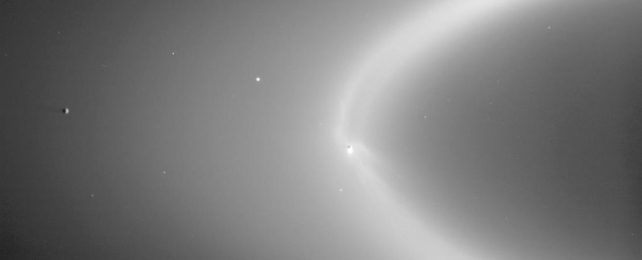Mystery silica ejected in huge quantities from Saturn's icy moon Enceladus is powerful new evidence pointing to heat vents on the floor of a global ocean.
According to a new analytical model, internal heating from the moon's core creates ocean currents that transport the silica particles, which are ejected from deep-sea hydrothermal vents that also release heat into the surrounding waters.
It's a tantalizing finding that teases a real possibility of the existence of life, deep below an alien ocean on an alien world.
When the Cassini probe spent its years orbiting and studying Saturn, it made a surprising finding. The planet's E ring – the second outermost of the extensive ring system – has a composition rich in microscopic grains of silica, alongside the ices of water, ammonia, and carbon dioxide.
We've also detected silica particles coming from Enceladus in the form of icy plumes that erupt from fissures in the moon's thick icy shell; scientists have determined that the E ring's composition is supplied by Enceladus, from its rocky core. And the chemistry and size of the grains are suggestive of high temperatures.
But how the silica gets from Enceladus's core, up through the deep global ocean, to be ejected through the ice in plumes has been something of a conundrum.
Enceladus is quite a wonder. The moon is covered with a chunky shell of ice, averaging between 18 and 22 kilometers (11 and 14 miles) in thickness. But its orbit of Saturn isn't perfectly round, but elliptical, which means its distance from the planet varies – as does the strength of the gravity between them. This varying gravity stretches and compresses Enceladus, creating heating in its core.
Below the icy shell, therefore, lies a global liquid ocean over 10 kilometers deep, and the heat emanating from the core keeps the water from freezing. This also raises the possibility of hydrothermal vents, fissures in the seafloor through which heat escapes from the moon's interior.
Previous research suggested that the heat from Enceladus's interior should generate vertical convection currents in the ocean, similar to those seen on Earth. Now, a team of planetary scientists led by Ashley Schoenfeld of the University of California, Los Angeles, has created a model involving those currents to try to understand silica transport on Enceladus.
"It's like boiling a pot on a stove. Tidal friction adds heat to the ocean and causes upwelling currents of warm water," Schoenfeld explains.
"What our study shows is that these flows are strong enough to pick up materials from the seafloor and bring them to the ice shell that separates the ocean from the vacuum of space. The tiger-stripe fractures that cut through the ice shell into this subsurface ocean can act as direct conduits for captured materials to be flung into space. Enceladus is giving us free samples of what's hidden deep below."
The implications are pretty exciting. As previous research has found, the silica, and other materials detected by Cassini in Enceladus's plumes, are consistent with what might be found in and at hydrothermal vents.
Here on Earth, hydrothermal vents are crawling with life, even far beyond the reach of sunlight. Entire ecosystems thrive on a chemosynthetic food web, harnessing chemical reactions from elements interacting at high temperatures to produce energy, rather than the more common photosynthetic processes that rely on sunlight.
This has led astrobiologists to suppose that ice moons like Enceladus may be harboring life, even though they are far from the Sun, and the ocean floor receives no life-giving sunlight whatsoever.
The new study adds to a growing body of evidence that suggests if there are hydrothermal vents on Enceladus, and, if there is life there, then we might be able to detect it without having to attempt to penetrate the ice. An orbiter or lander – of which several are currently under consideration – might be able to find biomolecules right there on the moon's icy surface.
"Our model," says planetary scientist Emily Hawkins of Loyola Marymount University, "provides further support to the idea that convective turbulence in the ocean efficiently transports vital nutrients from the seafloor to the ice shell."
And isn't that an intriguing notion? We might have to change its name to Enticingeladus.
The research has been published in Communications Earth & Environment.
